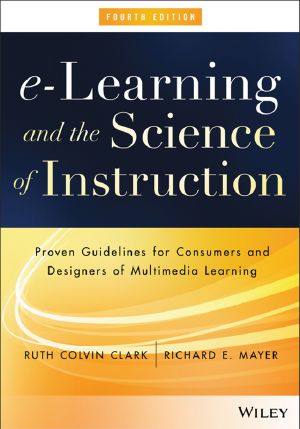E-Learning and the Science of Instruction

- Authors
- Clark, Ruth C. & Mayer, Richard E.
- Publisher
- Wiley
- Date
- 2016-03-21T00:00:00+00:00
- Size
- 16.31 MB
- Lang
- en
The essential e-learning design manual, updated with the latest research, design principles, and examples e-Learning and the Science of Instruction is the ultimate handbook for evidence-based e-learning design. Since the first edition of this book, e-learning has grown to account for at least 40% of all training delivery media. However, digital courses often fail to reach their potential for learning effectiveness and efficiency. This guide provides research-based guidelines on how best to present content with text, graphics, and audio as well as the conditions under which those guidelines are most effective. This updated fourth edition describes the guidelines, psychology, and applications for ways to improve learning through personalization techniques, coherence, animations, and a new chapter on evidence-based game design. The chapter on the Cognitive Theory of Multimedia Learning introduces three forms of cognitive load which are revisited throughout each chapter as the psychological basis for chapter principles. A new chapter on engagement in learning lays the groundwork for in-depth reviews of how to leverage worked examples, practice, online collaboration, and learner control to optimize learning. The updated instructor's materials include a syllabus, assignments, storyboard projects, and test items that you can adapt to your own course schedule and students.
Co-authored by the most productive instructional research scientist in the world, Dr. Richard E. Mayer, this book distills copious e-learning research into a practical manual for improving learning through optimal design and delivery.
Contents
Acknowledgements
Introduction
1. e-learning: Promise and Pitfalls
2. How Do People Learn from e-courses?
3. Evidence-Based Practice
4. Applying the Multimedia Principle: Use Words and Graphics Rather than Words Alone
5. Applying the Contiguity Principle: Align Words to Corresponding Graphics
6. Applying the Modality Principle: Present Words as Audio Narration Rather than On-Screen Text
7. Applying the Redundancy Principle: Explain Visuals with Words in Audio or Text but not Both
8. Applying the Coherence Principle: Adding Extra Material Can Hurt Learning
9. Applying the Personalization and Embodiment Principle: Use Conversational Style, Polite Wording, Human Voice, and Virtual Coaching
10. Applying the Segmentation and Pretraining Principles: Managing Complexity by Breaking a Lesson into Parts
11. Engagement in e-Learning
12. Leveraging Examples in e-Learning
13. Does Practice Make Perfect?
14. Learning Virtually Together
15. Who’s in Control: Guidelines for e-Learning Navigation
16. e-Learning to Build Thinking Skills
17. Learning with Computer Games
18. Applying the Guidelines
References
Glossary
List of Tables and Figures
Name Index
Subject Index
About the Authors
Get up to date on the latest e-learning research Adopt best practices for communicating information effectively Use evidence-based techniques to engage your learners Replace popular instructional ideas, such as learning styles with evidence-based guidelines Apply evidence-based design techniques to optimize learning games e-Learning continues to grow as an alternative or adjunct to the classroom, and correspondingly, has become a focus among researchers in learning-related fields. New findings from research laboratories can inform the design and development of e-learning. However, much of this research published in technical journals is inaccessible to those who actually design e-learning material. By collecting the latest evidence into a single volume and translating the theoretical into the practical, e-Learning and the Science of Instruction has become an essential resource for consumers and designers of multimedia learning.